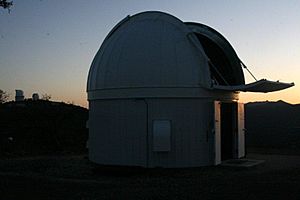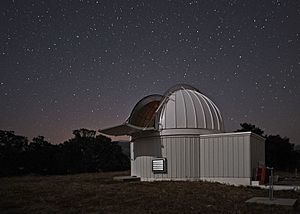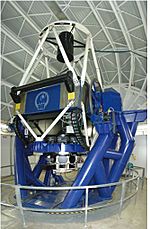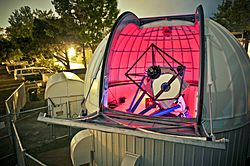Las Cumbres Observatory facts for kids
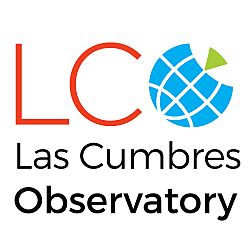 |
|
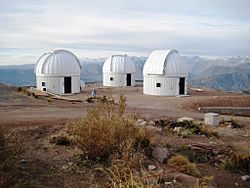
LCO node at Cerro Tololo, Chile.
|
|
| Founded | September 2005 |
|---|---|
| Founder | Wayne Rosing |
| Type | Not-for-profit organization, 501(c)(3) |
| Location | |
|
Key people
|
Lars Bildsten (BoD), Lisa Storrie-Lombardi (President & Observatory Director), Dorothy Largay (BoD), Wayne Rosing (BoD), Michael Skrutskie (BoD) |
| Website | www.lco.global |
Las Cumbres Observatory (LCO) is a special group of telescopes located all around the world. It is run by a non-profit organization, which means it uses its money to do science instead of making a profit. The project was started by technology expert Wayne Rosing.
LCO has telescopes in both the northern and southern halves of the Earth. Because they are spread out, they can watch stars and galaxies for 24 hours straight. As the Earth turns, one telescope can pass the job to the next one in the network.
The network uses a smart computer program to decide which telescope should look at which part of the sky. This makes sure that all the telescopes are used in the best way possible.
Contents
History of the Observatory
The idea for Las Cumbres Observatory began in 1993. Founder Wayne Rosing wanted to help scientists get better telescopes and tools for studying space. In 2005, he officially started the LCO we know today, with the goal of building a worldwide network of telescopes.
Building the Network
First, LCO got two large 2-meter telescopes. One is the Faulkes Telescope North in Hawaii, and the other is the Faulkes Telescope South in Australia. The team soon realized that having many smaller telescopes would be even more useful than just a few big ones.
So, they designed their own 1-meter telescopes. Between 2012 and 2013, they built and set up nine of these telescopes at observatories in Texas, Chile, South Africa, and Australia. They also created smaller 40-centimeter telescopes, which are great for school projects.
Becoming a Global Observatory
By 2014, the main network of telescopes was ready. The two 2-meter and nine 1-meter telescopes began working together as one giant observatory. Later, the smaller 40-centimeter telescopes also joined the system.
In 2016, the U.S. National Science Foundation gave LCO an award. This allowed all astronomers in the United States to use the LCO network for their research. This helps scientists prepare for new discoveries in time-domain astronomy, which is the study of how objects in space change over time.
The Global Telescope Network
LCO's telescopes are placed at seven professional observatories around the globe. This allows them to see the entire sky.
Telescope Locations
The network has sites in both the Southern and Northern Hemispheres.
Southern Hemisphere Sites:
- Cerro Tololo Interamerican Observatory (CTIO) in Chile
- South African Astronomical Observatory (SAAO) in South Africa
- Siding Spring Observatory (SSO) in Australia
Northern Hemisphere Sites:
- McDonald Observatory in Texas, USA
- Haleakala Observatory in Hawaii, USA
- Teide Observatory on the Canary Islands, Spain
- Ngari Observatory in Tibet, China
LCO also has a 1-meter telescope at its main office in Goleta, California, for testing new technology.
Types of Telescopes
LCO uses three different sizes of telescopes that work together.
2-Meter Telescopes
These are the largest telescopes in the network. They are called the Faulkes telescopes and are great for looking at faint, distant objects.
1-Meter Telescopes
These telescopes are the backbone of the LCO network. They have a wide field of view, meaning they can see a large patch of the sky at once.
40-Centimeter Telescopes
These smaller telescopes are mainly used for educational projects, allowing students to explore the universe.
How the Network Operates
The entire network acts as a single observatory. When a scientist wants to take a picture of a star, they don't pick a specific telescope. Instead, they just request a certain type of observation.
A smart software scheduler then finds the best telescope available to do the job. This schedule is updated every 15 minutes. If something exciting happens, like a supernova exploding, scientists can use a "rapid-response" mode. This allows a telescope to start observing the event in just a few minutes.
All the pictures and data are sent back to LCO headquarters in California. The data is processed and then sent to the scientists. After one year, the data is made public so anyone can use it for research.
Amazing Discoveries with LCO
The LCO network is perfect for studying things in space that change quickly. This is called time-domain astronomy. Because the telescopes can watch the sky continuously, they never miss the action.
LCO has been used to study exploding stars called supernovae, planets outside our solar system called exoplanets, and asteroids.
In 2017, LCO was part of two huge discoveries.
- It helped take the first picture of the light from a gravitational wave event. This happened when two neutron stars crashed into each other.
- It discovered a strange new type of supernova, IPTF14hls, that seemed to explode over and over again.
Education and Learning
Education has always been important to LCO. The observatory wants to help people of all ages get excited about astronomy.
LCO works with "Global Sky Partners," which are groups around the world that use the telescopes for educational projects. In 2019, these programs reached over 13,000 people, mostly students and teachers.
The LCO education team also runs its own fun programs. These include "Asteroid Tracker," where you can help find and track asteroids, and "Agent Exoplanet," where you can search for new planets. These projects let anyone use real telescopes to do real science.
See also
 In Spanish: Red Global de Telescopios del Observatorio Las Cumbres para niños
In Spanish: Red Global de Telescopios del Observatorio Las Cumbres para niños
- List of astronomical observatories
- Lists of telescopes
- Time-domain astronomy
- RoboNet


